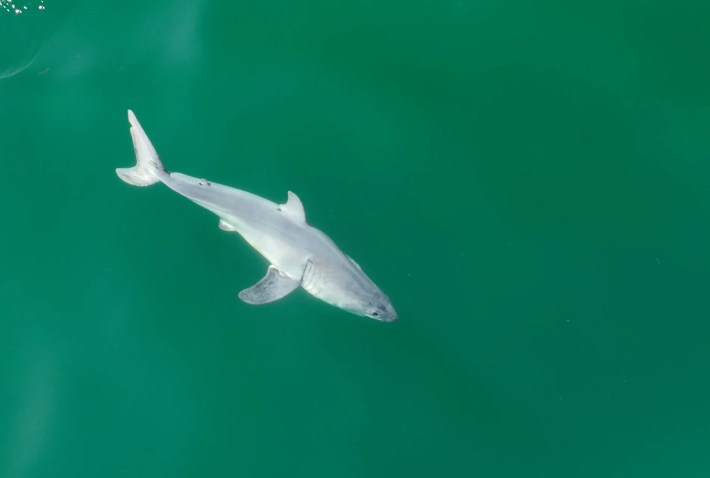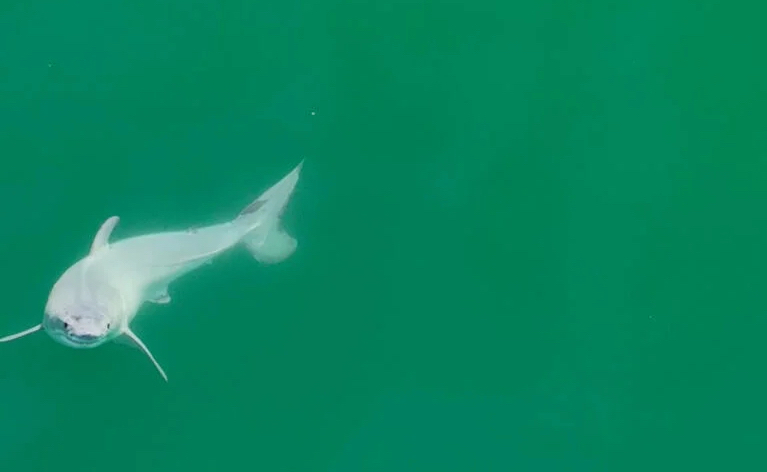This week, people collectively cooed at drone photography of a milky white shark pup floating near the surface in the greenish waters near Santa Barbara. The pup looked pristine, almost glossy, the skin of a shark that is too young to bear the scars that decorate elders of its species, souvenirs of battles with prey. In one still from the footage, the pup even seems to stare upward toward the camera with a gummy smile, its teeth totally obscured and its black eyes big and empty like a baby's should be.
The images were originally published in a paper in Environmental Biology of Fishes, whose authors suggested this could represent the first known footage of a newborn white shark. (Scientists just call them white sharks; we fans deemed them great.) The beautiful baby made headlines: "First ever sighting of a newborn great white reported" in CNN and "'Holy grail' of shark science: Newborn great white shark caught on video for first time ever" in Salon, among others.
But scientists are not totally convinced. "Sure, this could be a newborn shark, or it could be a shark with a skin disease, or it could be a number of other things we haven't even thought of," Chris Lowe, from California State University's shark lab told the BBC. Gavin Naylor, a shark researcher at the University of Florida, told Vox that "It seems more likely (to me) that this young animal may have been a couple of weeks old and strayed into shallow water."
Was this baby white shark not an infant after all, but a weeks-old veteran of the seas? Is there even that big a difference between a shark recently splurted out and a sharklet swimming into toddlerdom? I've dug into it, and here is everything you need to know about the possibly agefishing shark.

The Case For Baby
On July 9, 2023, Carlos Guana, a wildlife filmmaker, and Phillip Sternes,a graduate student at UC Riverside, were on the lookout for sharks off California's central coast, according to a UC Riverside press release. Gauna spotted the pup on his drone camera, swimming just about 1,000 feet from the beach. The duo enlarged the images and saw the shark appeared to be shedding white stuff from its skin. Gross? Maybe. Baby? Also maybe!
This is where I learned that sharks have "milk," which seems like untapped potential for the alternative milk industry. Pregnant white sharks secrete a cream-colored fluid called "uterine milk" for their embyros to consume. But white shark pups gestate for about a year, and scientists don't know if the mother produces this "milk" for the entirety of the pregnancy. White shark mothers can give birth to two to 17 pups, which are around four feet long and look like embryos with rounded fins. The researchers estimated the baby they filmed was about five feet long—still within the range for newborn sharks—and suggested the white substance the pup appeared to be shedding could be uterine milk that had adhered to its skin while in utero.
As further evidence, Gauna said in the press release that he'd observed "large, likely pregnant great whites" in the area in prior years and weeks before seeing the pup. “In my opinion, this one was likely hours, maybe one day old at most,” Sternes said in the press release. They suggest the footage of the baby means the area could be a birthing ground for white sharks, as researchers have previously speculated. “Where white sharks give birth is one of the holy grails of shark science," Gauna said.
The Case For Slightly Older Baby
Everyone agrees that the baby white shark is, in fact, a baby. But without actually seeing a tiny white shark emerge from a larger white shark, researchers can't know for sure how old the baby is, or what the whitish material could be. Gauna and Sternes offered another possible explanation for the substance that seems far less likely to inspire coos. Perhaps the shark has a "unique unknown skin disorder," they write in the paper. Sharks and rays have been observed with dermatitis and other bacterial infections, although none with symptoms that resemble this footage.
Although a skin condition is certainly a possibility, the most convincing argument against this being a true newborn is simply the lack of evidence. Robert Hueter, a senior science adviser for OCEARCH, told the Washington Post that he's not aware of any evidence that the intrauterine milk would congeal on newborns. And as Naylor pointed out to Vox and CNN, white sharks generally give birth to 8 to 12 pups at a time, raising the question of where the other newborns are. And as far as the question of what the baby's presence in the area reveals about white shark birthing grounds, the baby could have swum a great distance from the birthing area, as Greg Skomal, senior fisheries scientist at the Massachusetts Division of Marine Fisheries told CNN.
If The Baby Is Agefishing, So What?
Despite white sharks' dominance in popular culture and the scientific community, many aspects of their lives remain a total mystery. Scientists don't know if they give birth in shallows, like the stomping grounds of the Santa Barbara baby, or if they give birth farther out to sea. Learning more about the birthing grounds of the iconic sharks, which International Union for Conservation of Nature lists as vulnerable, helps scientists protect them—although as sharks and rays around the world face extinction due to overfishing, white shark populations actually appear to be increasing in U.S. waters.
For now, what this drone footage has actually captured—a beautiful milk-fed baby sloughing off its embryonic blanket, a slightly older baby shark having a skincare crisis, or some other, third thing—remains a mystery. But one thing is for sure: While human babies often need some time to dry out and plump up and actually look cute, shark pups are flawless from the get-go. And while the photo of this baby shark, even one of indeterminate age, may not be a holy grail as far as science is concerned, it has become, in my eyes, the Gerber Baby of cartilaginous fish, the jaws that launched a thousand "awwws."






